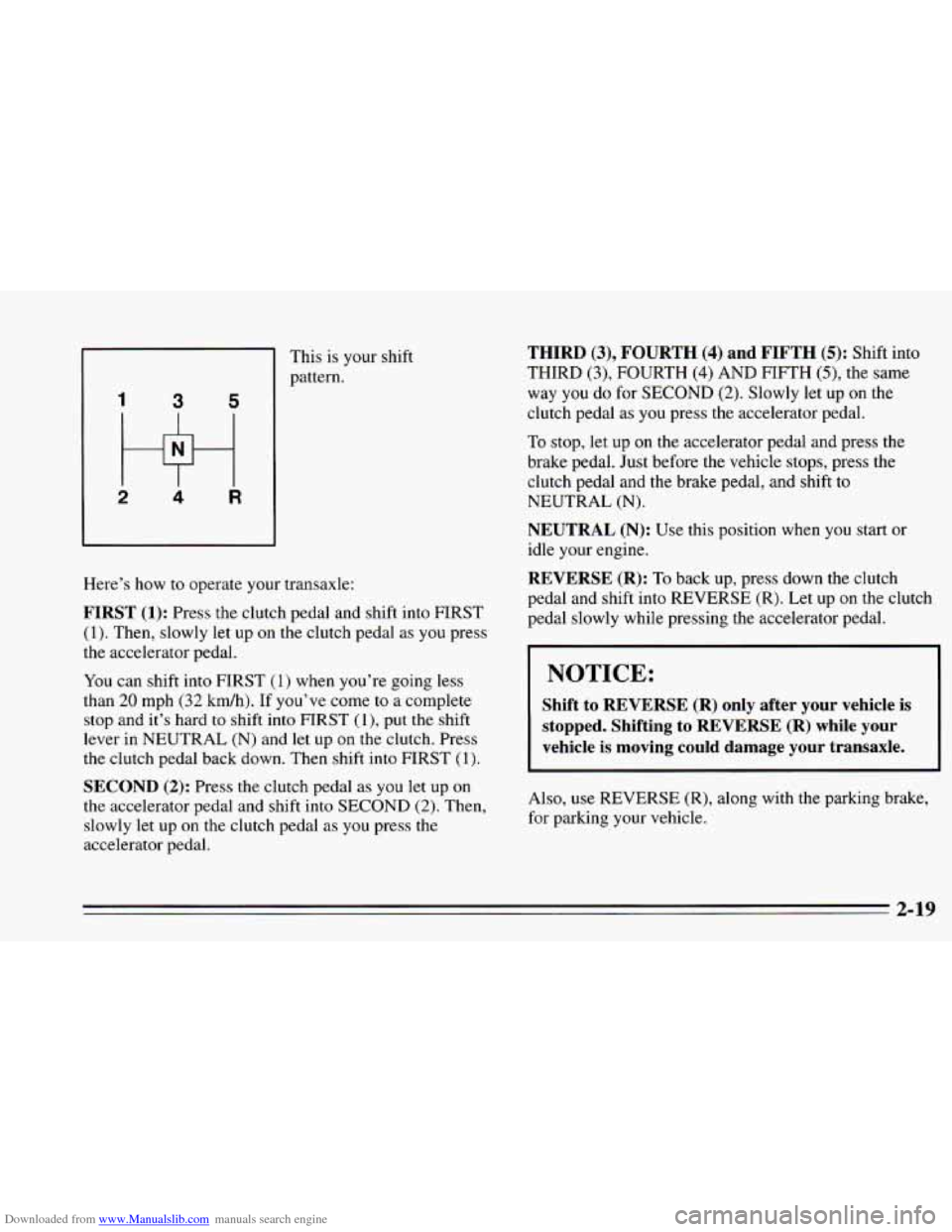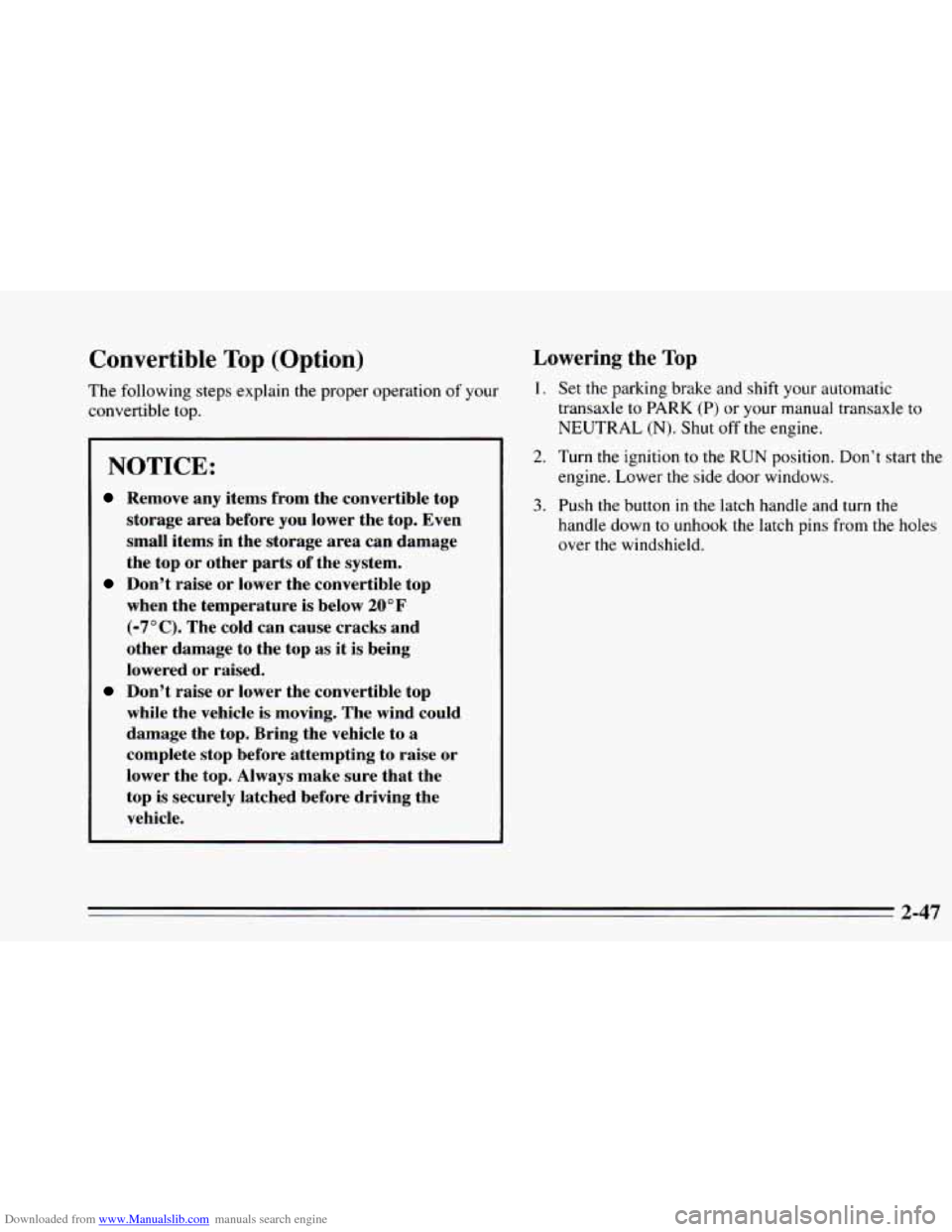Page 75 of 340

Downloaded from www.Manualslib.com manuals search engine 1
1 3 5
2 4 R
This is your shift
pattern.
Here’s how
to operate your transaxle:
FIRST (1): Press the clutch pedal and shift into FIRST
(1). Then, slowly let up on the clutch pedal as you press
the accelerator pedal.
You can shift into FIRST
(1) when you’re going less
than
20 mph (32 km/h). If you’ve come to a complete
stop and it’s hard to shift into
FIRST (l), put the shift
lever in NEUTRAL (N) and let up on the clutch. Press
the clutch pedal back down. Then shift into FIRST
(1).
SECOND (2): Press the clutch pedal as you let up on
the accelerator pedal and shift into SECOND
(2). Then,
slowly let up on the clutch pedal as you press the
accelerator pedal.
THIRD (3), FOURTH (4) and FIFTH (5): Shift into
THIRD
(3), FOURTH (4) AND FIFTH (5)’ the same
way
you do for SECOND (2). Slowly let up on the
clutch pedal
as you press the accelerator pedal.
To stop, let up on the accelerator pedal and press the
brake pedal. Just before the vehicle stops, press the
clutch pedal and the brake pedal, and shift to
NEUTRAL (N).
NEUTRAL (N): Use this position when you start or
idle your engine.
REVERSE (R): To back up, press down the clutch
pedal and shift into REVERSE
(R). Let up on the clutch
pedal slowly while pressing the accelerator pedal.
I NOTICE:
Shift to REVERSE (R) onIy after your vehicle is
stopped. Shifting to REVERSE
(R) while your
vehicle is moving could damage your transaxle.
Also, use REVERSE (R), along with the parking brake,
for parking your vehicle.
2-19
Page 77 of 340
Downloaded from www.Manualslib.com manuals search engine Parking Brake
~~~
NOTICE:
If you skip more than one gear when you
downshift,
or if you race the engine when you
downshift, you can damage the clutch or
transaxle.
The parking brake lever is located between the bucket
seats.
2-21
Page 78 of 340
Downloaded from www.Manualslib.com manuals search engine To set the parking brake, hold the brake pedal down and
pull up on the parking brake lever. If the ignition
is on,
the brake system warning light will come on.
To release the parking brake, hold the brake pedal down.
Pull the parking brake lever up until you can press the
release button.
Hold the release button in as you move
the brake lever all the way down.
I NOTICE:
Driving with the parking brake on can cause
your rear brakes to overheat. You may have to
replace them, and you could also damage other
parts
of your vehicle.
If you are towing a trailer and are parking on any hill,
see “Towing a Trailer’’ in the Index. That section shows
what to
do first to keep the trailer from moving.
Shifting Pnto PARK (P) (Automatic
Transaxle Models Only)
1. Hold the brake pedal down and set the parking
brake.
2-22
Page 79 of 340
Downloaded from www.Manualslib.com manuals search engine 2. Move the shift lever into the PARK (P) position like
this: Hold in the button on the lever, and push the
lever all the way toward the front
of your vehicle.
3. Move the ignition key to LOCK.
4. Remove the key and take it with you. If you can
walk away from your vehicle with the ignition key in
your hand, your vehicle is in PARK (P).
Leaving Your Vehicle With the Engine
Running (Automatic Transaxle Models
Only)
If you have to leave your vehicle with the engine
running, be sure your vehicle
is in PARK (P) and your
parking brake is firmly set before you leave it. After
you’ve moved the shift lever into the PARK (P)
position,
hold the regular brake pedal down. Then, see if
you can move the shift lever away from PARK (P)
without first pushing the button.
If you can, it means that the shift lever wasn’t fully
locked into PARK
(P).
2-23
Page 80 of 340

Downloaded from www.Manualslib.com manuals search engine Torque Lock (Automatic Transaxle)
If you are parking on a hill and you don’t shift. your
transaxle into PARK (P) properly, the weight
of the
vehicle may put too much force on the parking pawl in
the transaxle. You may find it difficult to pull the shift
lever
out of PARK (P). This is called “torque lock.” To
prevent torque lock, set the parking brake and then shift
into PARK (P) properly before you leave the driver’s
seat.
To find out how, see “Shifting Into PARK (P)” in
the Index.
When you are ready to drive, move the shift lever
out of
PARK (P) before you release the parking brake.
If “torque lock” does occur,
you may need to have
another vehicle push yours a little uphill
to take some of
the pressure from the transaxle, so you can pull the shift
lever out of
PARK (P).
Shifting Out of PARK (P)
(Automatic Transaxle)
Your Chevrolet has a brake-transaxle shift interlock.
You have
to fully apply your regular brakes before you
can shift from PARK
(P) when the ignition is in the
RUN position. See “Automatic Transaxle” in the Index.
If you cannot shift out of PARK (P), ease pressure on
the shift lever -- push the shift lever all the way into
PARK
(P) and also release the shift lever button on floor
shift console models as you maintain brake application.
Then move the shift lever into the gear
you wish. (Press
the shift lever button before moving the shift lever.)
If you ever hold the brake pedal down but still can’t
shift out
of PARK (P), try this:
1. Turn the key to OFF.
2. Apply and hold the brake until the end of Step 4.
3. Shift to NEUTRAL (N).
4. Start the vehicle and then shift to the drive gear you
want.
5. Have the vehicle fixed as soon as you can.
Parking Your Vehicle (Manual Transaxle)
Before you get out of your vehicle, put your manual
transaxle
in REVERSE (R) and firmly apply the parking
brake.
2-24
Page 94 of 340
Downloaded from www.Manualslib.com manuals search engine Instrument Panel Intensity Control Daynme Running Lamps (Canada Only)
You can brighten or dim the instrument panel lamps by
turning the dial up
or down.
Turn the dial up all the way
to turn on the interior
courtesy lamps. Daytime Running Lamps (DRL) can make
it easier for
others
to see the front of your vehicle during the day.
DRL can be helpful
in many different driving
conditions, but they can be especially helpful in the
short periods after dawn and before sunset. Several
countries, including Canada, require DRL.
The DRL system will make your high beam headlamps
come
on at a reduced brightness in daylight when:
0 The ignition is on,
0 The headlamp switch is off,
0 The parking brake is released and
On vehicles with automatic transaxles the shift lever
is moved from PARK
(P).
2-38
~~ -.
Page 95 of 340
Downloaded from www.Manualslib.com manuals search engine This indicator light on your
instrument panel comes
on
when DRL are on. When
you turn
off the headlamp switch, the regular
lamps will
go off, and your high beam headlamps will
come on
to the reduced brightness.
To idle your vehicle with the DRL off, set the parking
brake. The
DRL will stay off until you release the
parking brake.
As with any vehicle, you should turn on the regular
headlamps system when you need it.
When the
DRL are on, only your high beam headlamps
will be on at a reduced brightness. The taillamps,
sidemarker and other lamps won’t be
on. Your
instrument panel won’t be lit up either.
When
you turn on the headlamp switch, your high beam
headlamps will go out, and your headlamps will come
on. The other lamps that come
on with your headlamps
will also come
on.
Page 103 of 340

Downloaded from www.Manualslib.com manuals search engine Convertible Top (Option)
The following steps explain the proper operation of your
convertible top.
NOTICE:
Remove any items from the convertible top
storage area before you lower the top. Even
small items in the storage area can damage
the top or other parts of the system.
Don’t raise or lower the convertible top
when the temperature is below
20°F
(-7°C). The cold can cause cracks and
other damage to the top as it is being
lowered or raised.
Don’t raise or lower the convertible top
while the vehicle is moving. The wind could
damage the top. Bring the vehicle to
a
complete stop before attempting to raise or
lower the top. Always make sure that the
top is securely latched before driving the
vehicle.
Lowering the Top
1. Set the parking brake and shift your automatic
transaxle
to PARK (P) or your manual transaxle to
NEUTRAL (N). Shut
off the engine.
2. Turn the ignition to the RUN position. Don’t start the
engine. Lower
the side door windows.
3. Push the button in the latch handle and turn the
handle down
to unhook the latch pins from the holes
over
the windshield.
2-47